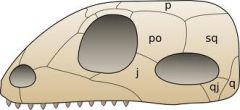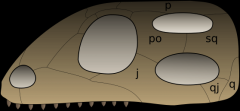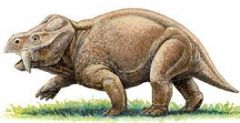![]()
![]()
![]()
Use LEFT and RIGHT arrow keys to navigate between flashcards;
Use UP and DOWN arrow keys to flip the card;
H to show hint;
A reads text to speech;
9 Cards in this Set
- Front
- Back
|
Anapsid
|

No holes in the skull. Ex: Turtles, amphibians, and fish.
|
|
|
Synapsid
|

Only the lower opening. Ex: Mammals and their relatives.
|
|
|
Diapsids
|

Two holes. Ex: Most reptiles, dinosaurs, pterosaurs, and birds.
|
|
|
What evolved at the end of the Triassic
|
First frogs, salamanders, turtles, lizards, snakes, crocodiles, mammals and dinosaurs. The Triassic is known as the "Dawn of the Dinosaurs" also the "Dawn of Modern Ecosystems"
|
|
|
Dicynodonts
|

First mammal like reptile.
|
|
|
Archosauria
|
Ruling Reptiles. Archosaurs divided into two groups: Crurotarsi and Ornithodira. Crurotarsi followed the line towards crocodiles. Ornithodira followed the line towards pterosaurs, dinosaurs and birds.
|
|
|
Dinosaur Origins
|
Dinosaurs diverged from their Archosaur ancestors about 230 million years ago during the Middle to Late Triassic period.
|
|
|
Ischigualasto Formation
|
Richest deposit dating from this time at the beginning of the Late Triassic Period is at the Ischigualasto Formation of Argentina. Gray colored rocks deposited in a humid environment have theropods like Eoraptor and Herrerasaurus. The most primitive ornithischian found in the formation, Pisanosaurus, is also found in the formation.
|
|
|
Characteristics of the first dinosaurs
|
Upright posture, open hip socket, opposable thumb for grasping, and a functionally three-fingered hand.
|

